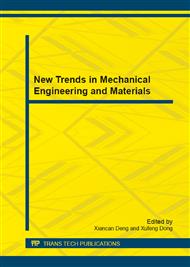[1]
Y.L. Yu, J.P. Hao, X.M. Du, et al. Maintainability engineering theory and method . Beijing: National Defense Industry Press, 416-428, 2007. (in Chinese).
Google Scholar
[2]
M.Z. Gan. Military equipment maintenance engineering . Beijing: National Defense Industry Press, 2005(in Chinese).
Google Scholar
[3]
MIL-HBDK-472. Maintainability prediction, military standardization h-andbook.
Google Scholar
[4]
Reliability engineering: Old problems and new challenges Reliability Engineering & System Safety, Volume 94, Issue 2, February 2009, Pages 125-141.
DOI: 10.1016/j.ress.2008.06.002
Google Scholar
[5]
W. Denson, The history of reliability prediction. IEEE Trans Reliab, 47 2-SP (1998), p.321–328.
Google Scholar
[6]
D. Kumar, U. Westberg. Proportional hazards modeling of time dependent covariates using linear regression: a case study. IEEE Transactions on Reliability 1996; 45: 386–92.
DOI: 10.1109/24.536990
Google Scholar
[7]
J.W. Kim, W.Y. Yun and T. Dohi. Estimating the mixture of proportional hazards model with incomplete failure data . Journal of Quality in Maintenance Engineering 2003; 9(3): 265–78.
DOI: 10.1108/13552510310493710
Google Scholar
[8]
W.J. Kolarik. E.L. Blair. B.N. Masters. Reliability and maintainability trade off study for rebetitive electromagnetic launch systems. IEEE Transactions on Magnetics, 25(1): 300-305., (1999).
DOI: 10.1109/20.22554
Google Scholar
[9]
P. Wikstrom, A. Lucien Terens and H. Kobi. Reliability, Availability and Maintainability of High-Power Variable-Speed Drive Systems. IEEE Transactions on Industry Applications, 361, 36(1): 231-241, (2000).
DOI: 10.1109/28.821821
Google Scholar
[10]
MIL-STD-470B. Maintainability prediction, military standardization handbook.
Google Scholar
[11]
Ghosheh, Emad and Qaddour, Jihad and Kuofie, Matthew and Black, Sue E. A comparative analysis of maintainability approaches for web applications. In: Proceedings of the IEEE International Conference on Computer Systems and Applications, Los Alamitos: IEEE Computer Society Washington, DC, USA. 1155-1158, (2006).
DOI: 10.1109/aiccsa.2006.205235
Google Scholar


